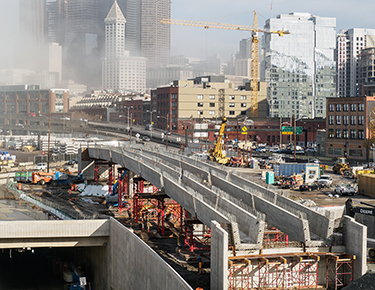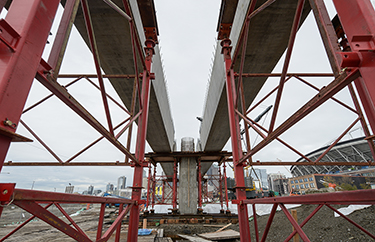|
Subscribe / Renew |
|
|
Contact Us |
|
| ► Subscribe to our Free Weekly Newsletter | |
| home | Welcome, sign in or click here to subscribe. | login |
Architecture & Engineering
| |
November 16, 2016
WSDOT testing new bridge that will bend but not break in a quake
Journal Construction Editor
Civil engineers have been designing bridges for years that can take the punishment of a large earthquake without collapsing. The problem is the bridges are unusable after a temblor.
What's needed is a bridge that can handle a quake and remain structurally sound.
All eyes are on Seattle now as the Washington State Department of Transportation builds the world's first bridge that is designed to snap back to its original shape after a magnitude 7.5 quake.
WSDOT is testing a combination of memory-retaining nickel/titanium rods and a bendable concrete composite in two columns for the Highway 99 exit ramp that is part of the Alaskan Way Viaduct replacement tunnel.
“This is potentially a giant leap forward,” said Tom Baker, WSDOT bridge and structures engineer. “We design for no-collapse, but in the future, we could be designing for no-damage and be able to keep bridges open to emergency vehicles, commerce and the public after a strong quake.”
Baker said WSDOT has been working toward resilient bridges for about eight years. The Earthquake Engineering Lab at the University of Nevada, Reno is helping WSDOT with research and design, under the direction of M. Saiid Saiidi, a civil engineering professor.
“Using shape-memory alloys, we are bringing the bridge back,” Saiidi said. “We are not allowing the bridge to have a permanent tilt.”
Baker said shape-memory alloys and bendable concrete composites are not new materials. He said the concept for the alloys dates to the 1970s, when they were used to make heat-detecting switches in specialized equipment.
The alloys from the 1970s were wire thin, but the alloys used in the bridge columns are No. 10 rebar size — about 1¼ inches in diameter. They are just as stiff as standard rebar but they can snap back without damage, similar to the way you can twist eyeglass frames made of titanium.
For the ramp project, WSDOT bought the bars before awarding a $3.5 million contract for the project to Interwest Construction. The bars came from SAES Smart Materials in New Hartford, New York. Couplings used to connect the bars to standard rebar were installed by Headed Reinforcement Co. in Fountain Valley, California.
The special alloy bars and bendable concrete are expensive so they were placed just in the top 5 feet of the columns. Baker said that's where the greatest loads occur during an earthquake. The rest of the columns were built to typical specifications.
Test columns at the Reno lab were subjected to simulated 7.5-magnitude quakes.
Baker said the test columns drifted more than 8 percent without significant damage. “It's that restorative force from the mechanical and chemical make up of the bar that is really exceptional,” he said.
Bendable concrete was created by adding tiny polypropylene fibers to the mix. Baker said the concentration of fibers is very high and there isn't a lot of big rock in the mix.
Bendable concrete is much more difficult to formulate than standard concrete, so crews had to mix it in small batches on the jobsite and pay strict attention. Baker said eventually it could be made at a batch plant.
Surface Systems supplied the engineered cementitious composite for the concrete. The company made the dry mix in Nevada, shipped it to Seattle and mixed it on site.
Surface Systems also provided the special concrete mix to researchers in Reno.
These specialized materials are up to 90 times more expensive than standard steel and concrete.
Baker estimated that making the bridge resilient to earthquakes added about $200,000 to the total cost. He expects the cost will come down in the future: “Anything done the first time tends to be more expensive.”
The Federal Highway Administration funded much of the additional cost for this pilot project.
Baker said the flyover ramp to South Dearborn Street was a good candidate for the pilot because it was designed with just two intermediate columns and has a short length of 400 feet. The rest of the bridge has two end piers supported by abutments and two rows of seven girders stretching over three spans.
The two columns containing the special rebar and concrete are at different locations in the bridge, which will let engineers see if that affects performance during the next quake.
“We're testing this cutting-edge technology in a real-live lab now,” Baker said. “We'll examine how it performs with heavy traffic volumes, rain, freezing and thawing cycles, and evaluate where we go from here.”
Baker said WSDOT is looking at how this technology could be used to retrofit existing bridges, but that will be much more complicated than building new.
For the moment, WSDOT has no other plans to use the technology.
Baker said it could be applied to other structures such as buildings. “Like a lot of new technologies, it will find all sorts of applications,” he said.
Interwest expects to have the Highway 99 ramp finished in late April, but motorists won't be able to use it until the tunnel opens in early 2019.
WSDOT has a new video about the pilot project below.
Benjamin Minnick can be
reached by email or by phone
at (206) 622-8272.




